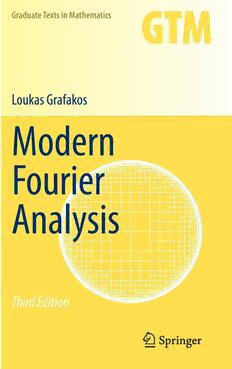Table Of ContentLoukas Grafakos
Modern Fourier Analysis, Third Edition
Solutions of all the exercises
March20,2014
Springer
Για την Iωα´ννα,την Kωνσταντ´ινα,και την Θεoδω´ρα
vi
Iwouldliketoexpressmydeepgratitudetothefollowingpeoplewhohelpedinthepreparationofthesolutionsofthebooks
ClassicalFourierAnalysis,3rdedition,GTM249andModernFourierAnalysis,3rdedition,GTM250.
Iremainsolelyresponsibleforanyerrorcontainedintheenclosedsolutions.
Mukta Bhandari, Jameson Cahill, Santosh Ghimire, Zheng Hao, Danqing He, Nguyen Hoang, Sapto Indratno, Richard
Lynch,DiegoMaldonado,HanhVanNguyen,PeterNguyen,JessePeterson,SharadSilwal,BrianTuomanen,XiaojingZhang,
Contents
vii
1 Smoothness and Function Spaces
1.1Smoothfunctionsandtempereddistributions
Exercise1.1.1
Givenmultiindicesα,β showthatthereareconstantsC,C(cid:48)suchthat
ρ (ϕ)≤C ∑ ∑ ρ(cid:48) (ϕ),
α,β γ,δ
|γ|≤|α||δ|≤|β|
ρ(cid:48) (ϕ)≤C(cid:48) ∑ ∑ ρ (ϕ).
α,β γ,δ
|γ|≤|α||δ|≤|β|
forallSchwartzfunctionsϕ.
(cid:2)Hint: The first inequality follows by Leibniz’s rule. Conversely, to express ξα∂βϕ in terms of linear combinations of
∂β(ξγϕ(ξ)), proceed by induction on |α|, using that ξj∂βϕ =∂β(ξjϕ)−∂βϕ−(βj−1)∂β−ejϕ if βj ≥1 and ξj∂βϕ =
∂β(ξ ϕ)ifβ =0.Hereβ =(β ,...,β )ande =(0,...,1,...,0)with1inthe jthentry.(cid:3)
j j 1 n j
Solution.
Firstofall,wenoticethat∂β(ξαϕ)isequaltoasumoftermsoftheformc ξγ∂β−γϕ,soanyρ (ϕ)isboundedbyafinite
γ α,β
sumofseminormsρ(cid:48) (ϕ).
γ,δ
Conversely,wefirstverifytheidentity
ξ ∂βϕ =∂β(ξ ϕ)−∂βϕ−(β −1)∂β−ejϕ
j j j
ifβ ≥1byinductiononβ .Indeed,saythatitholdsforβ .Then
j j j
∂β+ej(ξ ϕ)=∂ ∂β(ξ ϕ)=∂ (ξ ∂βϕ)+∂ (∂βϕ−(β −1)∂β−ejϕ)
j j j j j j j
=∂βϕ+ξ ∂β+ejϕ+∂β+ejϕ+(β −1)∂βϕ
j j
=ξ ∂β+ejϕ+∂β+ejϕ+β ∂βϕ
j j
fromwhichitfollowsthattheclaimedidentityholdsforβ +1.
j
Having verified the preceding identity, we conclude that ξ ∂βϕ can be expressed as a linear combination of terms of the
j
form∂γ(ξ ϕ)and∂γ(ϕ).Thenξ ξ ∂βϕcanbeexpressedasalinearcombinationoftermsoftheformξ ∂γ(ξ ϕ)andξ ∂γ(ϕ).
j k j k j k
Applying the preceding conclusion, we deduce that ξ ξ ∂βϕ can be expressed as a linear combination of terms of the form
k j
∂γ(ξ ξ ϕ),∂γ(ξ ϕ),∂γ(ξ ϕ),and∂γϕ.Continuinginthisway,weconcludethatanyξα∂βϕ isalinearcombinationofterms
k j k j
oftheform∂δ(ξγϕ(ξ)),thusanyρ(cid:48) (ϕ)isboundedbyafinitesumofseminormsρ (ϕ). (cid:4)
α,β γ,δ
1
2 Contents
Exercise1.1.2
Supposethatafunctionϕ liesinC∞(Rn\{0})andthatforallmultiindicesα thereexistconstantsL suchthatϕ satisfies
α
lim∂αϕ(t)=L .
α
t→0
Thenϕ liesinC∞(Rn)and∂αϕ(0)=L forallmultiindicesα.
α
Solution.
By assumption we have that lim ϕ(t)=L , and thus setting ϕ(0)=L , we have a continuous extension of ϕ on Rn.
t→0 0 0
Supposethatforall|α|≤N wehaveaCN extensionofϕ onRnforsomeN∈Z+.Wehave
∂αϕ(te )−∂αϕ(0) ∂αϕ(te )−L
∂ ∂αϕ(0)=lim j =lim j α =lim∂ ∂αϕ(ce )
j j t j
t→0 t t→0 t t→0
bythemeanvaluetheorem,wherec ∈(−t,t)\{0}.Theapplicationofthemeanvaluetheoremisallowedsincethefunction
t
s(cid:55)→∂αϕ(se ) is continuous on the closed interval [−t,t] and differentiable on the open interval (−t,t). By assumption the
j
precedinglimitexistsandisequaltoL .Thisisvalidforall j=1,...,nandthusϕ hasaCN+1extensiononRn. (cid:4)
α+ej
Exercise1.1.3
Letthatu ∈S(cid:48)(Rn).Supposethatu →uinS(cid:48)/P andu →vinS(cid:48).Thenprovethatu−visapolynomial.
N N N
(cid:2) (cid:3)
Hint:UseProposition1.1.3ordirectlyProposition2.4.1in[161].
Solution.
GivenaϕinS (Rn)wehave(cid:104)u ,ϕ(cid:105)→(cid:104)u,ϕ(cid:105)and(cid:104)u ,ϕ(cid:105)→(cid:104)v,ϕ(cid:105)byassumption.Then(cid:104)u−v,ϕ(cid:105)=0forallϕinS (Rn).
0 N N 0
PassingtotheFouriertransform,itfollowsthat(cid:104)u(cid:100)−v,ψ(cid:105)=0forallfunctionsψ with∂αψ(0)=0forallα.Inparticular,this
holds for all Schwartz functions that are supported in Rn\{0}. Then the distribution u(cid:100)−v is supported at the origin and it
followsthatithastobealinearcombinationofderivativesofDiracmasses(Proposition2.4.1in[161]).Thenu−vmustbea
polynomial. (cid:4)
Exercise1.1.4
Suppose thatΨ is a Schwartz function whose Fourier transform is supported in an annulus that does not contain the origin
andsatisfies∑j∈ZΨ(cid:98)(2−jξ)=1forallξ (cid:54)=0.Showthatforfunctionsg∈L1(Rn)withg(cid:98)∈L1(Rn)wehave∑j∈Z∆Ψj (g)=g
pointwiseeverywhere.
Solution.
Wewriteforeveryx∈Rn
(cid:90) (cid:90) (cid:90)
g(x)= g(cid:98)(ξ)e2πix·ξdξ = g(cid:98)(ξ)e2πix·ξ ∑Ψ(cid:98)(2−jξ)dξ = ∑ g(cid:98)(ξ)e2πix·ξΨ(cid:98)(2−jξ)dξ
Rn Rn j∈Z j∈Z Rn
wherethelaststepisjustifiedbytheLebesguedominatedconvergencetheoremsincegisintegrable.Butthelastexpressionis
(cid:98)
equalto∑ ∆Ψ(g),hencetheconclusionfollows.
j∈Z j
Contents 3
Exercise1.1.5
LetΘ andΦ beSchwartzfunctionswhoseFouriertransformsarecompactlysupportedandletΨ,Ω beaSchwartzfunctions
whoseFouriertransformsaresupportedinannulithatdonotcontaintheoriginandsatisfy
∞
Φ(cid:98)(ξ)Θ(cid:98)(ξ)+∑Ψ(cid:98)(2−jξ)Ω(cid:98)(2−jξ)=1
j=1
forallξ ∈Rn.Thenforevery f ∈S(cid:48)(Rn)wehave
∞
Φ∗Θ∗f+∑∆Ψ∆Ω(f)= f
j j
j=1
wheretheseriesconvergesinS(cid:48)(Rn). (cid:4)
Solution.
ItsufficestoshowthattheconvergenceholdsinS.Sowefixϕ inS.Weneedtoprovethat
N
sup (cid:12)(cid:12)∂ξβ(cid:2)(cid:8)1−Φ(cid:98)(ξ)Θ(cid:98)(ξ)−∑Ψ(cid:98)(2−jξ)Ω(cid:98)(2−jξ)(cid:9)ϕ(cid:98)(ξ)ξα(cid:3)(cid:12)(cid:12)→0
ξ∈Rn j=1
Thefunctioninsidethesquarebracketissupportedinasetoftheform|ξ|≥c2N forsomeconstantc.Moreover,thefunction
inside the curly brackets is bounded and all of its derivatives are bounded. But for any γ ≤β, ∂γ(ϕ(cid:98)(ξ)ξα) is a Schwartz
functionandthusithasrapiddecayatinfinity.Itfollowsthattheprecedingsupremumovertheset|ξ|≥c2N tendstozeroas
N→∞byLeibniz’srule. (cid:4)
Exercise1.1.6
(a)Showthatforanymultiindexα onRnthereisapolynomialQ ofnvariablesofdegree|α|suchthatforallξ ∈Rnwehave
α
∂α(e−|ξ|2)=Q (ξ)e−|ξ|2.
α
(b)Showthatforallmultiindices|α|≥1andforeachkin{0,1,...,|α|−1}thereisapolynomialP ofnvariablesofdegree
α,k
atmost|α|suchthat
|α|−1 1 (cid:18)ξ ξ (cid:19)
∂α(e−|ξ|)= ∑ P 1,..., n e−|ξ|
|ξ|k α,k |ξ| |ξ|
k=0
foreveryξ ∈Rn\{0}.Concludethatfor|α|≥1wehave
(cid:18) (cid:19)
(cid:12)(cid:12)∂α(e−|ξ|)(cid:12)(cid:12)≤Cα 1+|ξ1|+···+|ξ||1α|−1 e−|ξ|
forsomeconstantC andallξ (cid:54)=0.
α
(cid:2)
Hint:Forthetwoidentitiesuseinductionon|α|.Part(b):usethatthe∂ derivativeofahomogeneouspolynomialofdegreeat
j
most|α|isanotherhomogeneouspolynomialofdegreeatmost|α|+1times|ξ|−1.(cid:3)
Solution.
Toprove
∂α(e−|ξ|2)=Q (ξ)e−|ξ|2
α
startwiththecaseα =0whichisobviouslyvalid.Ifitisalsovalidforacertainα,lete =(0,...,0,1,0,...,0)andconsider
j
α+e .Wehave
j
4 Contents
∂ ∂α(e−|ξ|2)=(cid:2)(∂ Q )(ξ)−2ξ Q (ξ)(cid:3)e−|ξ|2
j j α j α
andnotethattheexpressioninthesquarebracketisapolynomialofdegree|α|+1.
Nextweprovethat
|α|−1 1 (cid:18)ξ ξ (cid:19)
∂α(e−|ξ|)= ∑ P 1,..., n e−|ξ|,
|ξ|k α,k |ξ| |ξ|
k=0
where the polynomials P have degree at most |α|. This identity is certainly valid for any multiindex α with |α|=1 by a
α,k
simplecalculation.Assumingthatitholdsforagivenα,thendifferentiatein∂ .Wefirstnoticethatforanymonomialwehave
j
ξβ 1 (cid:20) ξβ−ej ξβ+ej (cid:21)
∂ = β −|β|
j|ξ||β| |ξ| j|ξ||β|−1 |ξ||β|+1
ifβ isamultiindex,thus
(cid:18) (cid:19) (cid:18) (cid:19)
ξ ξ 1 ξ ξ
∂ P 1,..., n = P(cid:93) 1,..., n
j α,k |ξ| |ξ| |ξ| α,k |ξ| |ξ|
whereP(cid:93) ispolynomialofdegreeatmost|α|+1.
α,k
Theinductionhypothesisgives
∂ ∂α(e−|ξ|)
j
(cid:20)|α|−1 1 (cid:18)ξ ξ (cid:19) (cid:21)
=∂ ∑ P 1,..., n e−|ξ|
j |ξ|k α,k |ξ| |ξ|
k=0
=|α∑|−1(cid:20)− k ξj P (cid:18)ξ1,..., ξn(cid:19)+ 1 1 P(cid:93) (cid:18)ξ1,..., ξn(cid:19)− ξj 1 P (cid:18)ξ1,..., ξn(cid:19)(cid:21)e−|ξ|
|ξ|k+1|ξ| α,k |ξ| |ξ| |ξ|k |ξ| α,k |ξ| |ξ| |ξ||ξ|k α,k |ξ| |ξ|
k=0
=|α∑|−1 1 (cid:20)− ξj kP (cid:18)ξ1,..., ξn(cid:19)+P(cid:93) (cid:18)ξ1,..., ξn(cid:19)(cid:21)e−|ξ|−|α∑|−1 1 ξj P (cid:18)ξ1,..., ξn(cid:19)e−|ξ|
|ξ|k+1 |ξ| α,k |ξ| |ξ| α,k |ξ| |ξ| |ξ|k |ξ| α,k |ξ| |ξ|
k=0 k=0
= ∑|α| 1 (cid:20)− ξj ((cid:96)−1)P (cid:18)ξ1,..., ξn(cid:19)+P(cid:93) (cid:18)ξ1,..., ξn(cid:19)(cid:21)e−|ξ|−|α∑|−1 1 (cid:20)ξj P (cid:18)ξ1,..., ξn(cid:19)(cid:21)e−|ξ|
|ξ|(cid:96) |ξ| α,(cid:96)−1 |ξ| |ξ| α,(cid:96)−1 |ξ| |ξ| |ξ|k |ξ| α,k |ξ| |ξ|
(cid:96)=1 k=0
|α|+1−1 1 (cid:18)ξ ξ (cid:19)
= ∑ P 1,..., n e−|ξ|.
|ξ|m α+ej,m |ξ| |ξ|
m=0
Weexaminethedegreesofthepolynomialsinsidethesquarebrackets.Theyallhavedegreeatmost|α|+1.ThusP
α+ej,m
hasdegreeatmost|α|+1=|α+e |.
j
ThelastassertionfollowsfromtheboundednessofP ontheunitsphere. (cid:4)
α,k

